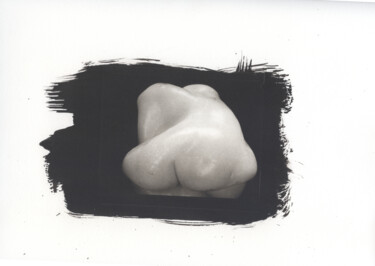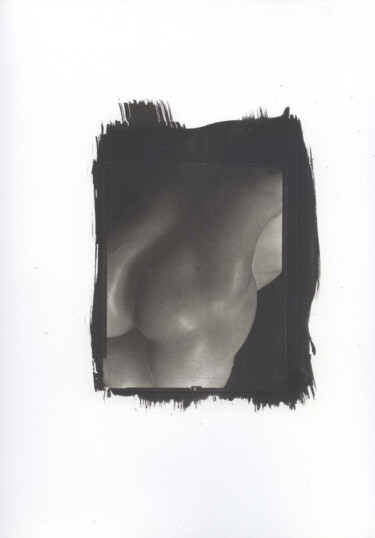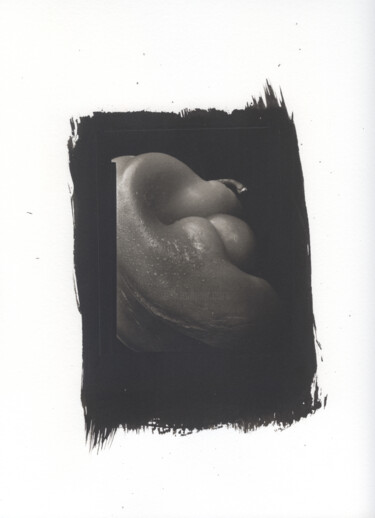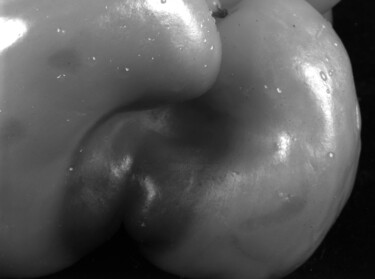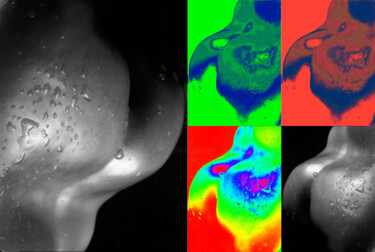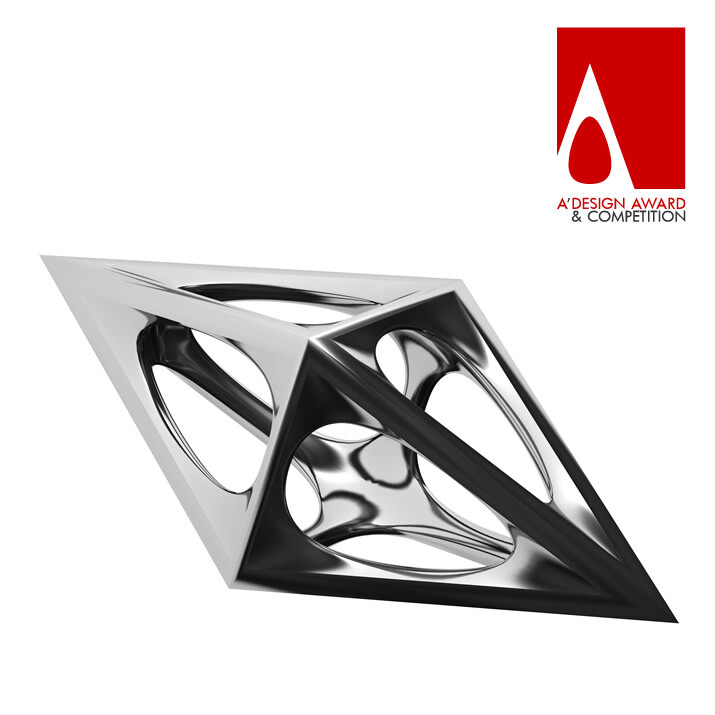Giuseppe Persia
Giuseppe Persia has been a photographer for more than 50 years, he started in the early 70s, he was a professional photographer and he worked for publishing. After a few years he left the studio to his collaborators to return to his old profession, advertising.
The "NUS-NOÛS" photographs were born almost by chance by observing a yellow pepper which, from a certain angle, looked like a human body. After overcoming a few obstacles such as light, the development of modified negatives and the use of microscope optics due to the short distance, the Nus Nous project was born, which means body and mind. This project, which began in 2000 and continues with new images, currently consists of approximately 1000 large format negatives (4x5 inches). The project was done in silver gelatin analog photography and is printed on cotton-backed paper with a selenium toner, as required for photographs held in museums. No intervention was made with retouching software, the image is as it is on the negative, once the print obtained some small retouching was done with a brush where there were small empty dots caused by the dust in the emulsion of the negative, no other intervention was made.
Early in the project, when attending art events, he noticed viewers stopping for a long time to admire the photos, often tilting their heads as if to observe the rotating image. Hence the rotating photo, an image mounted on a painter's easel and placed on a support that allows the observer to rotate it. Not everyone, looking at photographs, saw the same thing, the public often saw completely different things in the same image. The image does nothing but explore the most remote areas of our minds by bringing back old memories.
His photographs have been awarded by the Russian state with an exhibition at the Vernadsky Museum of Science and Culture (Kremlin Museum), he has received many important awards, the most recent being the silver A2 Design Awards & Competition 202.
Discover contemporary artworks by Giuseppe Persia, browse recent artworks and buy online. Categories: contemporary italian artists. Artistic domains: Photography, Digital Arts. Account type: Artist , member since 2010 (Country of origin Italy). Buy Giuseppe Persia's latest works on ArtMajeur: Discover great art by contemporary artist Giuseppe Persia. Browse artworks, buy original art or high end prints.

Artist Value, Biography, Artist's studio:
Stampa al Platino/Palladio • 3 artworks
View allNUS–NOÛS • 50 artworks
View allGiovanna Calvo Di Ronco.
I mitici anni 70! • 65 artworks
View allQueste immagini si rifanno appunto al neorealismo fotografico, scene di vita prese dalla strada. Non era una fotografia facile, niente messa a fuoco automatica, si usava il telemetro oppure si stimava la distanza “a occhio” e si riportava sull’obbiettivo, dopo la messa a fuoco avveniva la misurazione della luce, molte macchine fotografiche non avevano l’esposimetro incorporato, esisteva l’esposimetro esterno, si rivolgeva verso il soggetto, si sovrapponevano gli indici e si riportava la “coppia” tempo/diaframma sulla macchina fotografica, poi avveniva lo scatto.
Anche le pellicole avevano i loro problemi, scarsa sensibilità e una grana vistosa. Si poteva ovviare alla luce scarsa, nel caso di interni, con il flash, non quello elettronico, ogni lampo si buttava la lampadina vecchia e si inseriva la nuova. Fare una foto tecnicamente perfetta, cioè con il soggetto a fuoco e ben esposta non era facile e per attenuare gli errori dell’esposizione poco precisa, le pellicole non erano molto tolleranti, ci si atteneva ad una regola semplicissima ma efficace; ”Esporre per le ombre e sviluppare per le luci.”
Le foto bianconero del neorealismo hanno però fatto la storia della fotografia. Purtroppo questo tipo di immagine è scomparsa. Il giornalismo ha abbandonato l’immagine fissa sostituendola con brevi filmati, spesso fatti con i cellulari. Anche i grandi fotografi sono scomparsi.
Queste foto sono state prese tra l’inizio e la fine degli anni 70 e mostrano come si viveva allora.
Nelle foto, tecnicamente scarse, se paragonate a quelle digitali, si ricercava però una composizione armoniosa con un taglio preciso e molta importanza avevano la luce e le ombre.
Ultimamente non si punta più sul contenuto, non si racconta qualcosa, si vuole, anzi, si vorrebbe stupire con gli “effetti speciali”, in sintesi le belle fotografie, quelle da appendere, non esistono quasi più, esistono invece, nelle memorie elettroniche dei telefonini e delle macchine fotografiche digitali un numero enorme di file, questi oggetti, superelettronici, sono in pratica i cimiteri della fotografia.
Arte digitale • 14 artworks
View allVarie • 23 artworks
View allGiuseppe Persia
Photography | Several sizes
Giuseppe Persia
Photography | Several sizes
Pep Art • 19 artworks
View allDette immagini multiple sono congeniali per l’ interpretazione, appunto, delle fotografie NUS–NOÛS. Le immagini colorate a destra sembrano raffigurare corpi umani o parti di esso, in realtà è un peperone ma è l’osservatore che vuole vederceli. Quando si osserva una qualsiasi cosa, anche una situazione, la osserviamo in maniera emozionale e per questo, spesso, ci facciamo trarre in inganno.
L’immagine a sinistra, in bianco e nero, rappresenta lo stesso soggetto ruotato, in questa posizione non ha lo stesso significato delle immagini colorate, questo dura solo un tempo minimo, il tempo che le aree della mente si accorgano dell’inganno.
“Pep(per) Art” was born with the purpose of explaining the reading mechanism of “NUS-NOÛS” photographs and refers to Pop Art, artistic movement born in England in the 50s, whose most popular exponent was Andy Warhol, with his multiple images of marilyn. These images are congenial for the interpretation of the NUS-NOÛS” photographs.
The colored images on the right seems to represent human bodies or parts of them, in reality they are a pepper, but it’s the observer who wants to see them.
When we look at anything, even a situation, we observe it in an emotional way and this is why we often mislead ourselves. The black and white picture on the left represents the same rotated object. In this position it does not have the same meaning as the colored images. But this lasts for a very short time, the time the time that the areas of the mind become aware of the deception.
Il Castello di Ragogna • 18 artworks
View allStoria. (Da Wikipedia, l'enciclopedia libera)
Secondo alcuni storici, la denominazione Reunia, citata per la prima volta da Venanzio Fortunato - secolo VI - e da Paolo Diacono - secolo VII - è un termine di origine indoeuropea, etimologicamente legato alla presenza del fiume Tagliamento.
La presenza più antica sulla base delle ultime scoperte archeologiche risale al V millennio a.C., documentata da rinvenimenti di epoca meso-neolitica appartenuti ad una società agricola sulle colline del lago. La zona risulta successivamente abitata nella tarda età del Bronzo.
L'epoca romana è documentata dalla presenza di numerose "ville rustiche" e per la presenza del guado sul Tagliamento - Tabine. È in questo periodo che sorge a San Pietro di Ragogna il Castrum Reuniae, fortificazione lungo la pedemontana friulana a difesa della strada romana che portava al Norico.
In epoca longobarda diventa un importante centro in cui si rifugiano le popolazioni in occasione della invasione degli Avari; dalla fortezza muove, intorno al 695, il nobile Ansfrido per usurpare il ducato del Friuli. Dei secoli successivi - VIII, IX, X, XI - non si hanno informazioni, ma alcune testimonianze artistiche di notevole interesse documentano l'importanza che riveste il sito in questi secoli.
Verso il 1100 Ragogna risulta proprietà della famiglia tedesca degli Eppenstein (Duchi della Carinzia), i quali nel 1218 cedono il feudo ai von Wallenstein di Carinzia (imparentati con Albrecht von Wallenstein) che cambieranno il cognome in Ragogna. È il momento del massimo splendore. Durante le lotte fra il Patriarca d'Aquileia e i duchi d'Austria, i Ragogna si schierano con questi ultimi diventando famosi soprattutto per numerose operazioni di brigantaggio, finché nel 1365 il Castello viene espugnato dal Patriarca.
Nel XV secolo Ragogna diventa proprietà della Repubblica Veneta; successivamente, nel 1503, i conti di Porcia acquistano il feudo ed il Castello che, restaurato, diventa una residenza secondaria. Il terremoto del 1511 e l'incendio del 1560 sono fatali: il sito viene abbandonato definitivamente alla fine del secolo XVIII e donato al comune.
Friuli, 6 maggio 1976...... • 96 artworks
View allRitratti di guerra. • 138 artworks
View allRecognition
The artist is recognized for their work
The artist has won prizes and awards
The artist has been published in the media, radio or TV press
The artist's works have been noticed by the editorial staff
The artist participates in art shows and fairs
Exercises the profession of artist as a main activity
Biography
Giuseppe Persia has been a photographer for more than 50 years, he started in the early 70s, he was a professional photographer and he worked for publishing. After a few years he left the studio to his collaborators to return to his old profession, advertising.
The "NUS-NOÛS" photographs were born almost by chance by observing a yellow pepper which, from a certain angle, looked like a human body. After overcoming a few obstacles such as light, the development of modified negatives and the use of microscope optics due to the short distance, the Nus Nous project was born, which means body and mind. This project, which began in 2000 and continues with new images, currently consists of approximately 1000 large format negatives (4x5 inches). The project was done in silver gelatin analog photography and is printed on cotton-backed paper with a selenium toner, as required for photographs held in museums. No intervention was made with retouching software, the image is as it is on the negative, once the print obtained some small retouching was done with a brush where there were small empty dots caused by the dust in the emulsion of the negative, no other intervention was made.
Early in the project, when attending art events, he noticed viewers stopping for a long time to admire the photos, often tilting their heads as if to observe the rotating image. Hence the rotating photo, an image mounted on a painter's easel and placed on a support that allows the observer to rotate it. Not everyone, looking at photographs, saw the same thing, the public often saw completely different things in the same image. The image does nothing but explore the most remote areas of our minds by bringing back old memories.
His photographs have been awarded by the Russian state with an exhibition at the Vernadsky Museum of Science and Culture (Kremlin Museum), he has received many important awards, the most recent being the silver A2 Design Awards & Competition 202.
-
Nationality:
ITALY

- Date of birth : 1949
- Artistic domains: Works by artists with a certified artist value, Works by professional artists,
- Groups: Certified Artists Professional Artist Contemporary Italian Artists
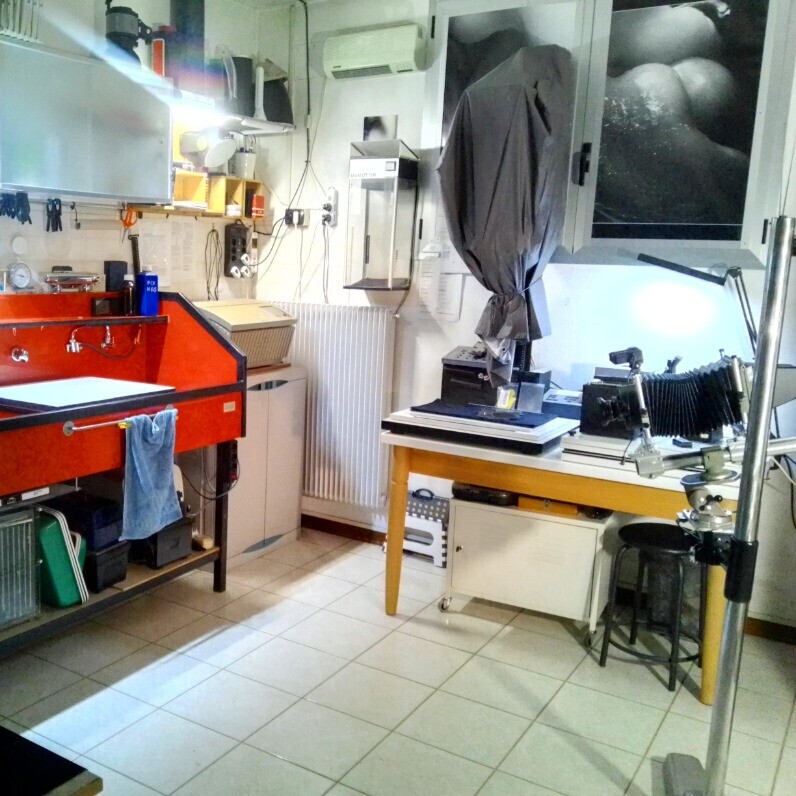
Ongoing and Upcoming art events
Influences
Education
Artist value certified
Certification established in collaboration with Akoun, the world leader in art market information since 1985.

Artist Value Work on paper 2021 | €800.00 ($931.84)
Certification has been established by Jacques-Armand Akoun on Jul 26, 2021.
Achievements
Collective Expositions
Permanent Collections
Solo Expositions
Activity on ArtMajeur
Latest News
All the latest news from contemporary artist Giuseppe Persia
Museo del Cremlino, Mosca (Russia)
Mosca, Russia
<h5>Informazioni sul libro</h5><p>Il Castello di Ragogna, situato in Friuli, è stato da me fotografato il 13 Febbraio del 1976, il 6 Maggio dello stesso anno, tre medi dopo, il disastroso terremoto del Friuli lo distrusse completamente. Queste son<
Novità? Usa questo spazio per parlare, al tuo pubblico e a chi ti segue, del tuo lavoro attuale, dei tuoi eventi, progetti, idee. Il tuo blog è una pagina di testo libero: puoi anche scrivere del tuo stato d'animo o di ciò che vuoi!
<span style="font-size: 18px;">Dal giorno 4 al 16 ottobre 2016 saranno esposte 9 fotografie "Nus Nous" nel prestigioso spazio della Mediolanum Art Gallery di Padova, sede dell’omonima Banca Mediolanum, piazzetta Giuseppe Bussolin, 15






<br><br>Galleria D'Arte Moderna via S. Maria Maddalena 24 Thiene (VI)<br><br>


STAZIONE PER VIAGGIATORI DI IDEE NOMADISMI D’ARTE CONTEMPORANEA 29 APRILE - 29 MAGGIO 2016


MUSEO MIIT TORINO.


Tecnica "NUS–NOÛS"
Quindici anni fa inizio un percorso nuovo, mi accorgo che un peperone, dalla forma inusuale, assomiglia stranamente ad un corpo umano, decido di fotografarlo, i risultati però sono scadenti, in fotografia non sembra quello che io avevo in mente, faccio decine di tentativi, cambio soggetto, luce, obbiettivi.
La superficie lucida dell'ortaggio mi alza enormemente il contrasto, per tenerlo sotto controllo uso diluizioni di sviluppo molto alte, anche la luce mi da problemi, la superficie lucida restituisce riflessi difficili da controllare.
La parte tecnica non è molto semplice, le foto in realtà sono macro-fotografie, la distanza dal soggetto è di pochi centimetri, la profondità di campo meno di un centimetro, tanto che sono costretto a diaframmi molto chiusi, f 64 e anche f 90, che mi portano l’esposizione ad alcuni minuti, l’allungamento del soffietto arriva fino a 30 cm, le ottiche a quella brevissima distanza hanno una resa molto bassa, decido così di usare ottiche adatte alle brevi distanze, quelle da microscopio, le monto su un otturatore Copal 3 con un banco ottico 4x5.
Dopo oltre un anno di lavoro e centinaia di negativi 4x5 ottengo 30 soggetti interessanti, li stampo su cartoncino opaco 30x40 cm con passepartout nero, li monto su pannello 40x50 cm, il risultato lo trovo eccezionale.
Insieme con la dottoressa Giovanna Calvo di Ronco, che prepara il testo, battezziamo la serie di immagini "NUS–NOÛS", letteralmente il corpo e la mente.
Le immagini sono molto suggestive, alcune sembrano nudi, altre un intreccio di corpi, qualcuna spudoratamente scandalosa.
"Nus Nous" lancia un messaggio, che non riguarda solo le immagini ma anche le situazioni.
Tutto quello che vedi, anzi, che credi di vedere, può non essere la realtà.
L'esploratore guardando le nubi vi scopre paesaggi misteriosi, il giocatore di poker l'asso di picche.
ARTAVITA.



PRIMA ESPOSIZIONE INTERNAZIONALE DI ARTE CONTEMPORANEA VENEZIA OPEN ART.



Sagra del peperone di Zero Branco (TV)
Nel 2006 nei locali della sagra del peperone di Zero Branco vengono esposte 35 opere "Nus Nous".

Bersagliere a vent'anni, bersagliere tutta la vita!
Biennale Internazionale di Arte e Cultura "ROMART" 2015



ArtExpo Metropolis 2‏ Roma<br><br><br><img class="fr-dib fr-draggable img-framed" src="http://giuseppepersia.artmajeur.com/medias/standard/g/i/giuseppepersia/site/415/cattura111.jpg" style="width: 831px; height: 601.19px;"><img class="fr-dib fr-dragga
youtube
https://www.youtube.com/watch?v=NG1toa9Xkmg
artists in the world
http://www.artintheworld.net/drupal/content/presentazione-artisti-di-artexpo-metropolis-2
https://www.youtube.com/watch?v=NSFPWvJW_Tc
Corjavascript:;diali saluti and regards
Angelo Ribezzi
Webmaster
Artists in the World
http://www.artintheworld.net/

INTERNATIONAL ART EXPO' MILANO
L'opera "PEPERONE GIALLO" ha partecipato all'evento con Giorgio Forattini dal 24 gennaio al 14 febbraio 2015.
Nella sezione VIDEO si può visionare un filmato con l'inaugurazione dell'evento, Giorgio Forattini e le opere partecipanti.
"INTERNATIONAL ART EXPO" MILANO.




Ho partecipato all'evento con l'opera "PEPERONE GIALLO"
ARTPROTAGONIST 2015
VILLA CONTARINI PIAZZOLA DI BRENTA PD ITALY
ARTEFICIOlinea
L'associazione artistica e socio-culturale ARTEFICIOlinea, promuove attività artistiche ad alto livello al di sopra di qualsiasi interesse di mercato con particolare riguardo alla valorizzazione dei Maestri Storici dell'Arte Contemporanea delle generazioni anni '20, '30 e '40.

ArtExpo Metropolis 2
vicolo Della Vaccarella, 12 Roma
Si inaugura sabato 6 giugno 2015 alle ore 18 a Roma in Galleria La Vaccarella in Vicolo della Vaccarella,12 00186 http://www.lavaccarella.org/ la seconda edizione dell’evento artistico internazionale a Roma, ArtExpo Metropolis.
La galleria si trova in pieno centro storico di Roma, in una delle zone piu belle ed esclusive, tra Piazza Navona ed il Pantheon,
Il direttore Artistico della galleria e curatore della mostra è Renato Costrini.
L'organizzazione è Artists in the World di Angelo Ribezzi.
Saranno in mostra artisti provenienti dall'Italia, dall'Algeria, dalla Finlandia, dalla Francia, dalla Germania, dall'Irlanda, da Israele, dal Giappone, dalla Romania, dalla Russia, dall'Inghilterra e dagli Stati Uniti: queste provenienze piu' disparate, testimoniano il carattere globale della manifestazione, che unisce insieme artisti provenienti da culture diverse ma che sono uniti dallo stesso linguaggio universale dell'arte.
Reviews and comments



